In January this year, I decided to treat myself to a spontaneous post-birthday trip to Chiapas. I found lots of fun things to do in San Cristobal de las Casas and just as many amazing places to eat. I met some lovely travelers (most solo like me) at the hostel and during a free walking tour. Overall, it was one of my favorite trips I’ve taken in Mexico… And that’s a lot!
Whether you’re going solo, with friends, family, a partner etc, I’m sure you’re going to love this idyllic, colorful city in Chiapas state. Outdoorsy types can use the city as a launching point for exploring natural attractions like waterfalls and canyons, while city dwellers will be kept busy by colorful shopping markets, cute cafes, and informative museums. There’s also lots to be learned in terms of the history, especially in the nearby indigenous villages.

What to do in San Cristobal de las Casas, Mexico
Despite being a relatively small city, San Cris is bursting with attractions, while the surrounding state of Chiapas offers caves, waterfalls, lakes, and Mayan ruins. I’ll try and cover a bit of everything in this San Cristobal travel guide… Along with some food tips, my specialty!
Take a free walking tour
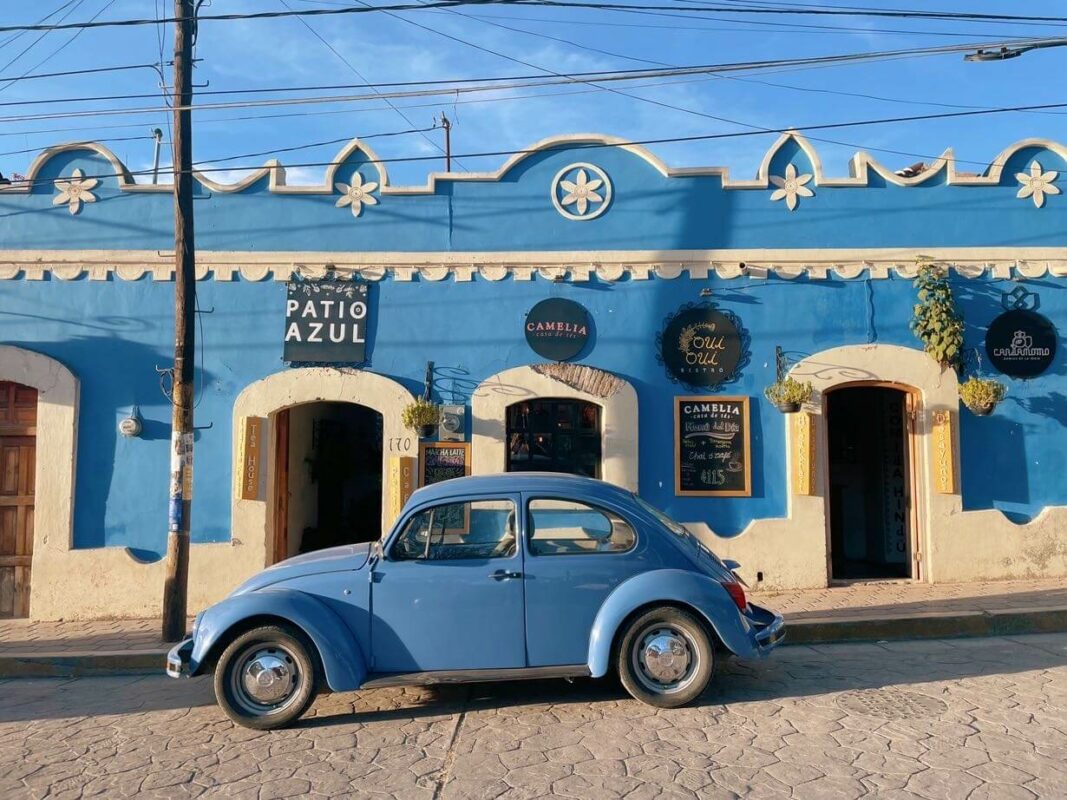
I’ve taken many free walking tours around the world but few I’ve enjoyed more than this one. Our guide was really informative and I came away feeling like I understood the city better, from its history to its current social problems.
A few topics covered on the tour included:
- The horrible history of Coca-Cola and how they exploit the region and water supply
- A brief history of the architecture from Spanish to Baroque and Moorish (our guide pointed out how a Burger King has nabbed a spot in one of the prettiest old buildings!)
- The history of amber spanning 45 million years
- A summary of the local indigenous dress (if you don’t have time to visit the indigenous villages, which I’ll discuss later, this is a good chance to gain insight)
- Details about the churches and their significance. I’d have never spotted some of these small, intricate details alone
- Facts about the street art including interpretations of the meanings and messages in the murals
- Food and nightlife recommendations for after the tour.
If you’re the kind of person who loves fun and quirky facts, don’t miss the walking tour!
The other reason I loved the walking tour so much was that I chatted with another solo traveler who recognized me from my blog and showed me tabs open on his phone where he was planning his Mexico trip using my advice! I was so happy. We made friends with a few other travelers and went for tacos after the tour. Travel is the best!
Departure details: the free walking tour begins at the wooden cross in Plaza de la Paz (exact location pinned here) every day at 10am and 4pm in English, and 10am in Spanish.
What’s the etiquette with tipping on a free walking tour? I would suggest 100-200 pesos. Some people will give more, while budget backpackers may give less. It depends what you can afford and what you feel the tour is worth.
Hang out in the main square

Almost every Mexican city has a ‘zocalo’, in other words, a central square or plaza where locals gather. Usually, it’s bordered by historic buildings and at least one church.
This charming city is no exception. Plaza de la Paz is one of the main attractions in San Cristobal de las Casas. Whether or not you’re interested in visiting the cathedral, it’s worth exploring the main square because it’s one of the most atmospheric, bustling places in the city with plenty of local life to be seen.
Vendors trundle across the square selling balloons in every shade of the rainbow; locals of all ages congregate to chat and sit in the shade; portable ice cream stands sell helado (ice cream) in flavors not limited to mamey, tamarind, and guanabana. To miss soaking up the vibes would be to miss the beating heart of SC!
Feeling adventurous? Try a chamoyada made from fruit, ice cream, and chamoy. For those who don’t yet know this famous Mexican sauce, it’s spicy and sour, made with dried fruit (apricot, mango, or plum), spicy chili, salty Tajin, and sour hibiscus flowers.
Don’t miss the open-air night market that happens every evening beside the cathedral in Plaza de la Paz!
Main sights around the Plaza:
- Plaza 31 de Marzo – the other notable Zocalo square beside Plaza de la Paz. At its heart is a bandstand where marimba music plays at night. It’s a peaceful spot surrounded by greenery and benches where locals come to congregate.
- Saint Nicolas temple – a pretty yellow church that’s one of the oldest in the city. Like many buildings, it can only be viewed from the outside since it’s being restored due to earthquake damage.
- Los Portales – this impressive building is easy to spot; just look out for the many archways.
Visit the churches
San Cristóbal de las Casas Cathedral: this sunny yellow church at the heart of the city is known for its intricate carvings, ancient wooden altarpieces, and art by Juan Correa. Construction began in 1528 and took several centuries to complete. As a result, it showcases a mix of architectural styles, including Baroque and Moorish.


Templo de Santo Domingo de Guzmán: engulfed by Mercado de la Caridad (the city’s most popular crafts market), this 16th-century church is another impressive place to visit in San Cristobal. Since the 2017 earthquake, it’s been closed for renovation. If it’s half as beautiful inside as it is outside, I can’t wait to come back and visit it.

Templo de la Transfiguración del Señor: a cute red and white church beside Cerrillo Park. This park and whole neighborhood is a pleasant place to visit in San Cristobal in its own right.
Swing by Arco del Carmen

Andador del Carmen is a pedestrianized street that connects the main square with Calle Real de Guadalupe and the pretty Arco del Carmen. At night, it’s a popular bar street yet it’s tranquil by day. Arco del Carmen is a pretty, historic building that once served as a gateway to the city.
Although you can’t go inside, it’s worth swinging by and admiring from the outside.
Soak up the vibes on Calle Real de Guadalupe

Probably the most popular place to visit in San Cristobal is Real de Guadalupe. With low-rise historic buildings and shops selling local handicrafts, this atmospheric walking street feels like it hasn’t changed in decades.
Don’t miss the chance to stroll this gorgeous street, ice cream or coffee in hand, observing the blend of locals and tourists rubbing shoulders. Live music often plays so park yourself in a cafe (there are lots of charming coffee shops to choose from) to soak up the vibes!
Whether or not you’re looking for this street, you’ll find it because it connects many of the key attractions in San Cristobal.
Get off-the-beaten-track in Barrio del Cerillo
This peaceful barrio (district) just north of the city center is a good place to visit once you’ve ticked off the main things to do in San Cristobal de las Casas. It’s a gorgeous, traditional part of town characterized by cobbled streets and colorful houses.
It’s recently received some modern influences in the form of vibrant street art! This is the best place in San Cristobal to spot murals. I’ll tell you exactly where to find them later.
For the nicest sunset viewpoint, head to the corner of Belisario Domínguez and Comitan, pinned here.
Pick up souvenirs at Mercado de la Caridad (crafts market)


Need souvenirs? If so, one of the best things to do in San Cristobal is find Mercado de la Caridad y Santo Domingo in the center of the city. This lively artisan market is overflowing with every type of Mexican handicraft imaginable from embroidered leather bags, cushions, key rings, jewelry, clothing, homeware, and other decorations.
There’s not a color you won’t see in this vibrant wonderland!
Sure, it’s pretty touristy with items that you can find in other locations in Mexico (for example the many markets in Mexico City) but buying is a great way to support local vendors and artisans, many of whom travel from villages in Chiapas state every day to make a living. It’s open from around 9am-8pm daily.
I was fascinated by the vast array of amber, thought to prevent bad luck. Available in a range of hues including red and green, much of it is sourced from a small town in Chiapas state not far from San Cris.
Tip – since it’s easy to make fake amber, you should check it’s real before buying. Simply shine a light into the piece and, if it changes color, it’s fake. Many vendors in the market shine torches into their amber products as you walk by to advertise the validity of their store.
Soak up the culture at Mercado Municipal José Castillo Tielemans (local market)

Although the colorful crafts market mentioned above is one of the best places to visit in San Cris, you’ll be rubbing shoulders with tourists rather than locals. To compare, I suggest you head to the local Mercado Municipal José Castillo Tielemans.
Fruits, vegetables, meats, fish, piñatas, sweets, nuts, and fake designer goods overflow the many stands at this indoor market. The sights, sounds, and smells of this local shopping hub – combined with the hustle and bustle of people going about their daily business – is a sensory overload, but a rewarding one!
Unless you’re planning to cook (the fresh produce here is far cheaper than at any supermarket), you’re less likely to buy here and more likely to browse while soaking up the local life.

Safety – I felt perfectly safe walking around this market as a solo woman but it goes without saying that in any busy, crowded space, you should be aware of your surroundings and keep your belongings close, preferably in a secure, cross-body bag.
If you’re planning on taking photos of local people and the goods they’re selling, always ask first to be polite and respectful. A ‘puedo tomar un foto?’ goes a long way!
Shop at the Sweets and Amber Market


To complete the San Cristobal market circuit, I’d recommend paying a visit to Mercado de Dulces y Artesanias Ambar. As the name suggests, it sells lots of delicious local sweets and amber. However, you can get general local handicrafts there. I bought a beautiful peacock tote bag that I’m still wearing daily 6 months later! I only paid 100 pesos.
Don’t miss Cacao Nativa cafe next door – they do amazing chocolate truffles in loads of flavors, plus rich drinking chocolate.
Try Chiapas coffee

Did you know that the state of Chiapas is the biggest coffee-producing region in Mexico, accounting for 40% of all crop? With plenty of cute and quirky coffee shops, San Cristobal is the perfect place to try it!
Two places to buy beans to take home are Carajillo Expendio and Cafe Ka. Although Cafe Ka is more of a coffee store than a cafe, the friendly owner made me a cup anyway and I sat on the window sill chatting to him in Spanglish for a while.
After you’ve ticked off the main things to see in San Cristobal, sit back and enjoy Chiapas coffee in a cafe. Two of my favorites are Amor Negro coffee shop and Frontera Artisan Food.
Related San Cristobal activity: Chiapas coffee workshop
Explore the culinary scene
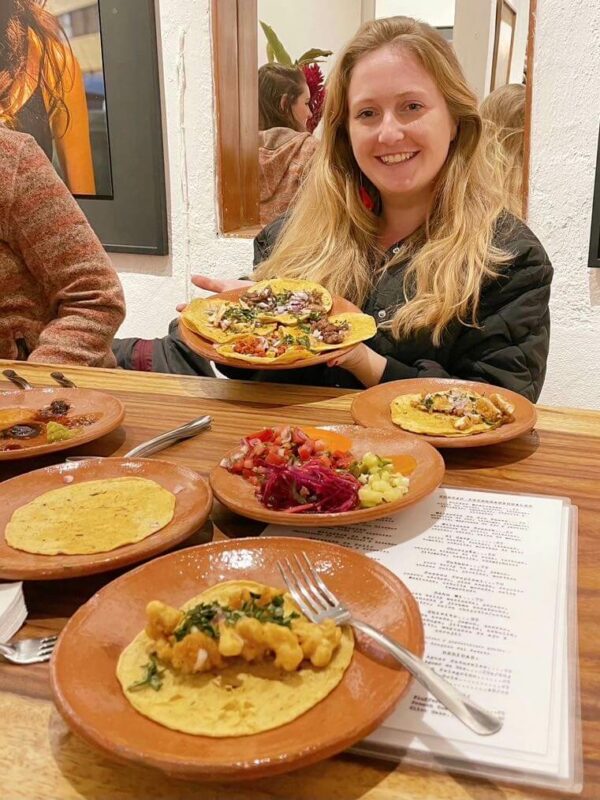

Foodies take note! There’s so much tasty food to try. I put together a whole guide to the best restaurants in San Cristobal de las Casas but here’s a quick summary:
- Best sit-down dinner – Nostalgia, Xut
- Best tacos and tortas – Click
- Best lunch – Tipica
- Best brunch – Sarajevo (this cafe is so beautiful!)
- Best bakery – Roots
- Best vegan food – Kukulpan.
You can find all your unusual Mexican foods here (as well as international food) but here are a couple of regional dishes popular in Chiapas:
- Sopa de pan – bread soup is a popular dish made with a rich sauce comprising tomato, green beans, spices, and a hardboiled egg
- Tescalate – a hot or cold drink made for centuries using corn, sugar, achiote, and pine nuts
- Pozol – not to be confused with pozole soup (a popular Mexico City street food), this is another popular drink made with corn and cacao. It’s usually served cold… Very refreshing in the summer!
Find street art

I love finding street art wherever I go, and every Mexican city seems to have fantastic offerings. It usually tells a story or speaks of the struggles felt by local people. Many murals here support the Zapatista movement led by a far-left group that disputes government actions such as selling Chiapas land to the US and Canada.

Don’t miss the social chaos mural on Dr Navarro, the beautiful bird mural by Kukulpan cafe, or this blue jaguar by artist, Primo, all in Barrio del Cerrillo.
Take a day trip to Sumidero Canyon


Although we’re far into this blog post, it’s in no particular order because this is probably THE best thing to do in San Cristobal de las Casas. Sumidero Canyon is easily one of the most beautiful natural places I’ve been in Mexico. After a year living here, I’ve been lucky to visit countless gorgeous locations so this is high praise!
Measuring 16 miles in length and up to 1000 meters in depth, the canyon is home to animals including crocodiles and vultures. We were lucky to see several huge crocs basking on the water’s edge.
The best way to explore the canyon is by boat. Speeding through the waters, glancing up at towering, 200m cliffs, I was in awe! Our guide pointed out a structure known as Cascada del Árbol de Navidad (Christmas Tree Waterfall) that apparently grows 10cm a year due to mineral-rich water droplets solidifying.
I really enjoyed that the Canyon doesn’t feel TOO touristy. Although many people visit each day, the vast expanse of the canyon means you rarely see other boats. It’s certainly not crowded. The commentary given by the boat drivers is only in Spanish and, while I didn’t understand everything, I liked the local feel, although sadly there was a lot of trash in the water.
How to Sumidero Canyon from San Cristobal
A guided day tour is the best option for ease and convenience because you don’t have to navigate public transport. Also, you’ll meet other travelers and learn about the canyon from a local guide. I recommend this Viator tour including hotel pickup, canyon boat ride, and a stop in Chiapa de Corzo for $75.
If you want to DIY it and take public transport, catch a bus to Chiapa de Corzo (70 pesos) then find the colectivos destined for embarcadero. If you plan to visit Tuxtla during your Chiapas trip (where the main airport is), it’s easier to visit the canyon from here than San Cris before it’s closer.
Explore quaint Chiapa de Corzo

If you’re visiting Sumidero Canyon, give some time to the quaint town beside it. Voted a pueblo magico (a ‘magic town’ assigned by the tourist board to places with a unique and rich culture), Chiapa de Corzo is an idyllic settlement with buckets of history, delectable local cuisine, and a famous UNESCO-recognized annual festival.
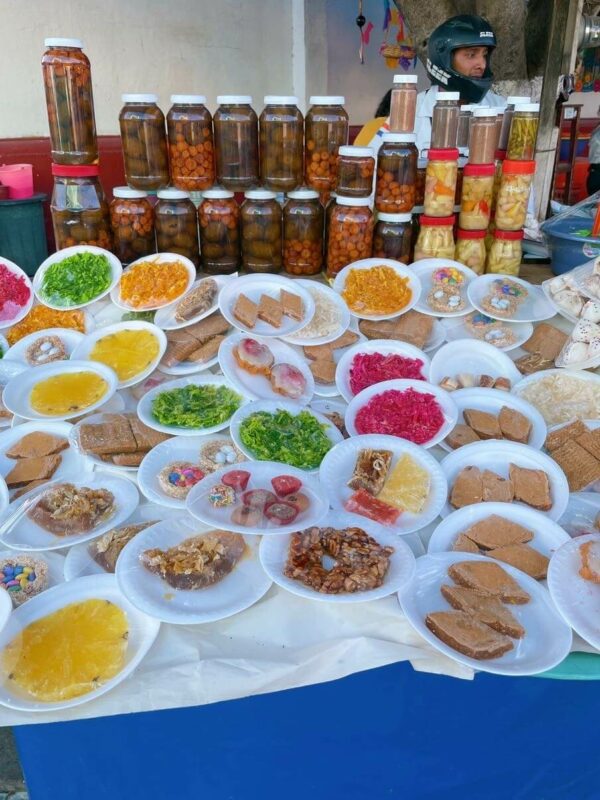

Attractions in Chiapa de Corzo include:
- Temple and convent of Santo Domingo de Guzmán – not to be confused with the one in San Cris, this church is home to the Lacquerware Museum displaying more than 450 intricate items from Mexico and Asia.
- The archaeological site of Chiapa de Corzo dating back to 1400 BC!
- Mudejar Plaza and Fountain – a 16th-century fountain pictured above.
A great time to visit Chiapas de Corzo is January because of the La Fiesta Grande, a cultural celebration dating back to the 17th century and recognized on UNESCO’s Intangible Cultural Heritage List. Three days dedicated to Catholic saints see parades with masked Parachico performers, fireworks, music, and local food.
Sadly, I visited in January but due to being on a guided Sumidero Canyon tour, we didn’t have time to watch the fiesta. Although I still think a tour is the easiest way to visit Sumidero, the obvious downside is being on a tight schedule. I’d love to come back and stay overnight in Chiapas de Corzo… Watch this space!
Getting to Chiapas de Corzo: from San Cristobal, the drive takes just under 1 hour on Highway 190. You can also get there without a car by catching a bus to Tuxtla Gutiérrez then boarding a cheap colectivo the rest of the way.
Visit indigenous villages, San Juan Chamula and Zinacantan

One of the most important and eye-opening things to do in San Cristobal is take a day trip to the indigenous villages nearby, San Juan Chamula and Zinacantan. Although the cultures and customs vary between the two villages, they’re comparable (and usually visited together) due to their similar autonomous nature with cultures predating Spanish rule.
San Juan Chamula: this is the best-known of the two villages, inhabited by Tzotzil people who have managed to retain much of their ancient culture.
Iglesia de San Juan Church is a picturesque church with a green and white facade, colorful mosaics around the doorway, and huge cultural significance. Blending prehispanic rituals and Catholic traditions, you’ll find pine needles covering the floor, incense burning, and Catholic saints holding mirrors to ward off evil. You may even witness a chicken sacrifice!

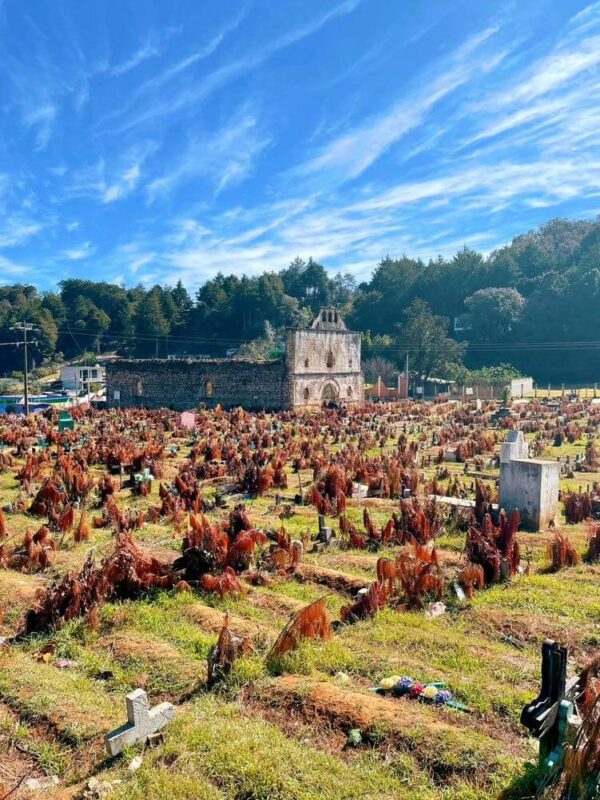
Here, you’ll learn how a community has become hooked on Coca-Cola. It’s cheaper to buy than clean water so many locals drink it, instead; estimates suggest the average person here drinks 2 liters A DAY! It’s even become integral to religious ceremonies, consumed for healing purposes, replacing a substance used in prehispanic times.
Zinacantan: not far from Chamula, this indigenous village translates in Tzotzil as ‘place of the bats’. The town is known for its woven clothing and floral embroidery, mostly produced by the local women’s cooperative. For artisan shopping that supports local livelihoods, be sure to make your purchases here. San Lorenzo Church is a pretty place to visit at the heart of Zinacantan.
How to visit the autonomous villages
I would highly recommend taking a guided tour like this one with a local guide to learn about the cultures. Also, so you can be kept informed about how to act appropriately and not cause cultural offense based on the local customs.
Another highly rated tour is this cycling tour around the villages with Jaguar Aventours for $55.
However, you can visit independently. To get to Chamula from San Cris, get a taxi the 30-minute drive or board a colectivo for 18 pesos each way.
The two villages are also connected by colectivo; the ride takes just 20 minutes.
Climb to Guadalupe Church

One of the best things to do in San Cristobal come sunset is climb the steep flight of 79 yellow and white stairs to Templo de Nuestra Señora de Guadalupe, one of the best city viewpoints. The climb isn’t particularly hard and the views are well worth it, even if the church itself isn’t the most impressive in the city.
Climb to San Cristóbalito (the church on the opposite hill)
To complete the viewpoint circuit, climb up to San Cristóbalito, the red and white church at the opposite end of town to Guadalupe Church. Although it’s the wrong side of the city for sunset, it offers lovely views in the daytime.
Although I didn’t count, I think San Cristóbalito has more steps than Guadalupe Church. It certainly felt steeper! I’d suggest going early to avoid climbing in the midday heat.
If you’re planning to visit the Amber Museum (more about this later), it’s a good place to incorporate into your San Cristobal sightseeing because it’s right next door.
Wander idyllic Na Bolom casa


For a quaint, historic place to visit in San Cristobal to escape the bustling city center, I can’t recommend Casa Na Bolom enough! This peaceful, sunny yellow hacienda dubbed ‘House of the Jaguar’ has decades of history, originally built in 1891 as a seminary for priests.
Later, archeologist Frans Blom and photographer, journalist, and environmental pioneer, Gertrude Duby Blom lived in the house. Now, it’s a museum and Maya research center where you can learn about their work and see local folk art.
Entry is 60 pesos. Just across the road, Jardín del Jaguar is a café in a lovely leafy garden. Ideal for a quiet secluded brunch or coffee!
Accommodation suggestion – Casa Na Bolom is also a boutique hotel! I didn’t stay here myself but my friend raved about it. Book from $70 a night.
Learn at the Jade Museum

For an informative thing to do in San Cristobal de las Casas, head to Museo Mesoamericano del Jade, a small collection of jade relics from the ages. Statues, masks, and ceremonial pieces represent jade’s spiritual importance to the Maya people.
Entry is just 30 pesos and also includes access to the Amber Museum across town. There are no English exhibits but, if your Spanish isn’t great, scan the signs through the Google Translate camera using the app.
There’s also a shop where you can browse and purchase jade items but, be warned, it’s not cheap! There are better bargains to be found at the local markets.
Make your own chocolate at the Chocolate Museum
Like the idea of hand-crafting your own chocolate bar? For 300 pesos, your dream can become a reality at Kakaw Museo del Cacao y Chocolateria Cultural Museum. It’s in the same building as the Jade Museum so you can tick off two San Cristobal attractions in one go.
The staff are super knowledgeable about the cacao process that’s been practiced for millennia, long before the beans were exported by Europeans and served in a solid form with milk. Shoot them your questions, sample the product, and even make your own bar in a demo class for 300 pesos!
Visit the Maya Textiles Museum (Centro de Textiles del Mundo Maya)
I didn’t initially have this place on my radar but I stumbled upon it after visiting the crafts market outside. It turned out to be a great find, hidden inside a beautiful old convent. Inside are over 500 handwoven textile items from handicrafts to clothes and artistry, originating from Mexico and Central America.
It has an interactive nature: some of the exhibits like Mayan outfits have large drawers underneath that you can pull out to see other handmade items inside. To learn more about Mayan cultures and customs through colorful items, give Centro de Textiles a visit. Even the building is beautiful to walk around. There are exhibits in English, and entry costs 60 pesos.
Learn at the Amber Museum


Tucked away in a grand 16th-century convent on the edge of town, this museum is the place to learn about this precious stone associated with the region. Amber was used in ancient rituals and even as medicine by the Mayans.
From fossils with ancient insects preserved inside to modern items like amber reading glasses and chess sets, there’s plenty to see and learn about. Some exhibits are in English but not all. Entry is 30 pesos and also includes access to the Jade Museum.
Find the best sunset views in town

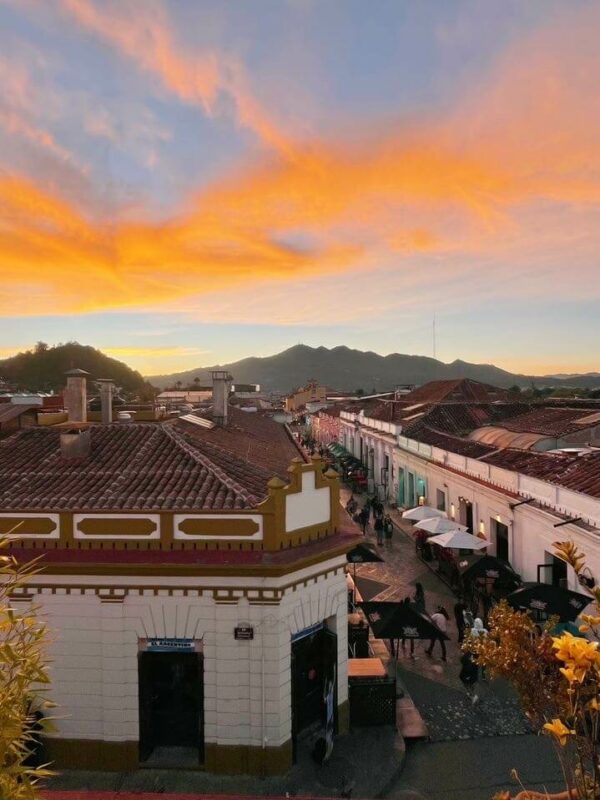
One of the top things to do in San Cristobal at sunset is soak up the views from a rooftop bar. Two of the best places I found are Kinoki and Monkydonas. Kinoki is a popular rooftop bar in the center of town overlooking Real de Guadalupe. Get there early to bag a good seat.
Kinoki is also a movie theater showing cultural films. Don’t miss it!
Monkydonas is more of a hidden gem near Guadalupe Church. I don’t get the impression it’s a well-known spot but my hostel friends and I stumbled on it around sunset and enjoyed VERY cheap mojitos on the rooftop!
Relax in cute bookshops
Thought San Cris couldn’t get more picturesque? Wait ’til you see the cute bookshop cafes! Some of my favorites include LibreArte (a cute old bookstore with street art murals outside), Libre Café, La Cosecha (by the bird mural across from Kukulpan cafe), and Art Libreria (a bookshop and organic vegan cafe with highly-rated food).
For a cozy way to spend an afternoon (especially if you visit in winter when it’s surprisingly cool), curl up with a good book and a warm Mexican drink like cacao!
Hang out in Jardin Cerillo
One of the coolest corners of San Cristobal that I stumbled upon was Jardin el Cerrillo, a peaceful courtyard with cafes and shops. Sitting at Frontera with an iced coffee and a bagel soaking up the sun was bliss!
It’s also the location of Posheria where you can try a local delicacy I’ll mention later…
Treat yourself at Esquina San Augustin

There are plenty of places in San Cristobal to try affordable, traditional Mexican food and, although Esquina San Agustin is not one of them, it’s still worth visiting. This stylish food court is a sight to behold, decked out with trees, potted plants, cool lampshades, and tiled floors.
With fancy food, international cuisine, third-wave coffee (I was a fan of Amor Negro coffee shop), and some of the most beautiful cakes I’ve ever seen, foodies may think visiting Esquina San Agustin is one of the top things to do in San Cristobal!

Read next: where to eat in San Cristobal de las Casas
Try Mexican wines at La Viña de Basco
Wine fans, do not miss this spot! Not only do they serve great wines and tapas, but the quirky bar with outdoor seating is located on Real de Guadalupe where live music plays. It’s a great atmosphere and, subsequently, hard to grab a table in peak periods. Get there early if possible! On a weekday afternoon, I managed to grab a table with no problems.
La Viña de Basco serve wines from Mexico’s Valle de Guadalupe wine region, as well as Chile, Argentina, and Italy – from 28 pesos a glass. Absolute bargain! Wine in restaurants in Mexico City (where I live) is always expensive so I was happy to find this little gem.

Learn about (and drink) pox
Have you heard about pox? After a trip to Chiapas, you’ll be an expert! Any local will tell you to try this regional drink (pronounced posh) used in Mayan ceremonies and translated to ‘medicine’ in Tzotzil. Made with corn, wheat, and sugarcane, pox has a strong taste that I can’t say I loved… But maybe I just need to drink it more!
Try pox at…
Posheria – a colorful place on Real de Guadalupe with beaded curtains and room for just a few people.
La Espirituosa – I tried pox here during the free walking tour. Whether or not you take the tour, I recommend stopping by to learn about this ancient drink from the friendly staff… And try it, of course!
Best things to do near San Cristobal de las Casas
If you’ve finished with the main tourist attractions in San Cristobal, why not get exploring Chiapas state? From hiking to ziplining, boat trips on majestic lakes, mesmerizing waterfalls, and Mayan ruins, here are some San Cris activities to keep you busy…
Reserva Ecológica y Orquideario Moxviquil
Just north of the city (a quick taxi ride or a 30-minute walk) is Reserva Ecológica y Orquideario Moxviquil, a pleasant nature reserve where you can forget about city life and soak up the beautiful flora and fauna.
Not only is it a lovely place to take a walk and spot wildlife, but they have an honorable mission: conserving nature for future generations!
El Arcotete Ecoturist Park

The main attraction here is the natural archway, formed by the Fogótico River cutting through the mountain. Entry to El Arcotete Ecoturist Park is just 10 pesos, although there are other attractions to explore (with equally small entry fees) for example walking through a cave, taking a pleasant boat ride… And adrenaline-inducing activities like rappelling and ziplining!
There are also several hiking trails within the park. You could spend anywhere between a couple of hours and the best part of a day there.
Getting to El Archotete from San Cristobal:
- Get a taxi – for around 100 pesos. It may be worth arranging the ride home with your driver because there aren’t many taxis waiting near the park exit. The staff can help you call one, but you may be waiting a little while.
- Ride a colectivo – find these near Guadalupe Church destined for Arcotete. This mode of transport should cost around 30 pesos return.
- Take a Viator GetYourGuide day tour also including Grutas de Rancho Nuevo ($25).
Have a cave adventure at Grutas de Rancho Nuevo
Drive 20 minutes from San Cristobal and you’ll come to a fantastic natural gem: Grutas de Rancho Nuevo, a magical complex with an entry fee of only 30 pesos (20 pesos for the cave entry and 10 pesos for general park entry).
Take a walk through the cave complex along a boardwalk, or hire a local guide to take you deeper into the cave with a helmet and torch. Other activities in the park include ziplines, huge outdoor slides, and horse rides.
Getting there from San Cristobal:
- Negotiate a price with a local taxi driver; it shouldn’t take more than 20 minutes or cost more than 150 pesos
- Hop in a colectivo which stops on the way to Teopisca
- Take a Viator GetYourGuide day tour also including Arcotete Park ($25).
Marvel at El Chiflon Waterfalls

El Chiflón is a series of waterfalls formed by the San Vicente River as it flows through the Chiapas Highlands. The main attraction is Velo de Novia (Bridal Veil), the tallest cascade in the region at 120 meters, however, there are four other waterfalls in the area which you can explore at your leisure.
Although many travelers visit the main points of interest as a day trip, there’s plenty to do in the park like ziplining and camping. You could spend several days here!
How to get to El Chiflon from San Cristobal:
- Take a day tour; I recommend the one listed below
- Take the OCC or ADO bus from around 100 pesos
- Ride a colectivo for around 30 pesos.
As El Chiflon is a 2.5-hour drive from the city, it’s a long day trip… But one of the best things to do near San Cristobal, regardless!
Book a tour to Chiflon & Montebello National Park for just $30 including round-trip transportation and a local guide.
Lagunas de Montebello National Park

Boasting 50 lakes and lagoons in a range of fantastic blue and green hues, Montebello National Park is part of a rich and complicated ecosystem with plenty of wildlife and oak tree forests, awarded UNESCO Biosphere Reserve status.
Activities in the national park include bird watching, hiking, and taking boat rides on the lakes. Some of the most popular ones are Lake Montebello, Cinco Lagos, Lago Pojoj, and Lago Tziscao. Lagunas de Montebello National Park is a 3-hour drive from San Cris, close to the border with Guatemala.
How to get there:
- Drive – this gives you freedom to stop at all the scenic viewpoints at your leisure
- Take an organized tour – the easiest option
- Public transport – catch a bus from San Cris to Comitan, then board a colectivo. Since it’s a long journey, it’s best to stay overnight. There’s plenty of accommodation in the park.
Agua Azul Waterfalls and Misol-Ha Cascade
The mesmerizing landscape of Chiapas is awash with natural treasures but few are more impressive than these cascades around 4 hours driving from San Cristobal.
Agua Azul and Misol-Ha Cascades are wonderful places to visit if you’ve ticked off the main things to do in San Cristobal de las Casas and you’re craving seeing more of Chiapas state. They’re different enough that it’s worth visiting both: Agua Azul is a wide set of cascades with beautiful, blue waters while Misol-Ha is a tall, towering cascade.
If you’re visiting Palenque during your Chiapas trip, they’re certainly easiest to visit from there. But day trips actually visit depart and return to San Cris during the same day including a stop at Palenque and the falls, although prepare for a longgg day out!
Entry to Misol-Ha is 40 pesos and Agua Azul is 50 pesos. Combine them with…
Palenque Mayan ruins

Probably the most famous place in Chiapas state is Palenque. This historic Mayan site enjoyed its heyday between the 5th and 8th centuries AD with many important temples such as the tomb of King Pakal. The ruins are mesmerizing to visit, shrouded in the ancient jungle.
Day trips depart San Cris as early as 4am, returning in the late evening. During the trip, you’ll visit Palenque as well as Agua Azul Waterfalls and Misol-Ha Cascade. It’s a long day out, and I’d personally prefer to stay overnight, however if you only have one day to spare, I don’t think you’ll regret visiting the UNESCO World Heritage Site that is Palenque!
Entry is 110 pesos including access to the museum.
To stay overnight, take a bus from San Cris to Palenque town and organize your excursions from there.
Book your Palenque day trip from San Cris including stops at Agua Azul and Misol-Ha Cascades for just $60 with GetYourGuide.
Tips for visiting San Cristobal
The water is bad: not only do Coca-Cola’s antics leave little water for the locals, but many of the water sources are contaminated. In my hostel dorm, every other guest got violently sick during the 6 days I was there (luckily, I escaped), and I heard so many horror stories from other travelers I met. It goes without saying that you should not drink the tap water… But you also shouldn’t brush your teeth with it. Many people will even tell you to sanitize after washing your hands. Yup, it’s bad!
It can get cold at night: when I visited in January, I was stunned at how cold it felt once the sun went down, even if it had been hot during the day! I remember getting horribly sunburnt at Sumidaro Canyon then coming back to the city and being utterly freezing, sleeping in all my clothes under loads of blankets in my hostel which wasn’t especially well insulated. Such a contrast!
Mobile data is bad: I kept thinking my mobile data had run out, then it would come on sporadically. The mobile signal is surprisingly bad in San Cristobal so I would not recommend coming here to work remotely.

How to get to San Cristobal de las Casas
By air – Angel Albino Corzo International Airport, also known as Tuxtla Gutierrez International Airport, is the nearest airport, 80km away. To get between the airport and San Cris, you can hire a car, take a taxi for around 800 pesos, or board an ADO mini bus (250 pesos). Buses run until around 10pm. Be sure to book a flight that lands before then if you’re hoping to get a bus.
By car – driving in Mexico is relatively straightforward and I recommend Rentalcars.com for car hires. However, San Cris isn’t close to many other popular tourist cities, for example, it takes around 9 hours to drive from Palenque, 12 hours from Oaxaca, and 11 hours from Campeche.
By bus – ADO and OCC buses serve San Cris but get ready for some long journeys! Journey times are similar to the driving ones listed above, sometimes times 1-2 hours longer.
How to get around San Cristobal de las Casas
On foot – I walked everywhere in San Cris. It’s a small city so you rarely need transportation. To the out-of-town attractions like the indigenous villages and Sumidero Canyon, I took guided day tours with GetYourGuide and Viator.
By city trolley – this is a fun thing to do in San Cristobal as well as a transport option. These historic open-top trolleys trundle around the city stopping at the main sightseeing attractions. There’s a commentary but only in Spanish.
Taxi – there’s no Uber but you can agree rates with local drivers.
Colectivos – jump in these local minibusses to reach attractions on the outskirts and further afield. They’re a super cheap way to get around.

FAQs
Is San Cristobal de las Casas safe? Yes, it’s certainly a pleasant and safe city for tourists. But it’s worth noting that Chiapas as a state has a 75% poverty rate making it one of the poorest in Mexico, plus there’s civil unrest relating to the Zapatista movement. So be sure to do your research before visiting new places in the area.
How long to spend in San Cristobal de las Casas? Although you could see the city center in a day, I spent 5 days in San Cris and I think this was perfect to explore the city leisurely and take a couple of day trips. If you have time for just two, I would prioritize Sumidero Canyon (which you can see during the same day as Chiapa de Corzo) and the indigenous villages, San Juan Chamula and Zinacantan.
When is the best time of year to visit San Cristobal de las Casas? Peak period is November to April when the rainy season is finished. Still, you can’t go too wrong because San Cris is pleasant throughout the year with daytime highs hovering between 70-90°F (20-32°C).
In the winter, bring a jacket because nighttime temperatures can drop to 30°F (0°C). Muy frio!
Is San Cristobal, Mexico worth visiting? If the 6,000 words above haven’t persuaded you, then YES, San Cristobal is well worth visiting for the rich culture, history, nearby nature, shopping markets, and more!
Thanks for reading my San Cristobal de las Casa travel guide!
Read more Mexico blogs:

